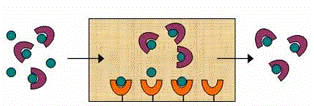Chemistry, Department of: Faculty Series

David Hage Publications
Document Type
Article
Date of this Version
2020
Citation
Published in Journal of Pharmaceutical and Biomedical Analysis 177 (2020) 112882
doi 10.1016/j.jpba.2019.112882
Abstract
Affinity capillary electrophoresis (ACE) is a separation technique that combines a biologically-related binding agent with the separating power and efficiency of capillary electrophoresis. This review will examine several classes of binding agents that have been used in ACE and applications that have been described for the resulting methods in clinical or pharmaceutical analysis. Binding agents that will be considered are antibodies, aptamers, lectins, serum proteins, carbohydrates, and enzymes. This review will also describe the various formats in which each type of binding agent has been used in CE, including both homogeneous and heterogeneous methods. Specific areas of applications that will be considered are CE-based immunoassays, glycoprotein/glycan separations, chiral separations, and biointeraction studies. The general principles and formats of ACE for each of these applications will be examined, along with the potential advantages or limitations of these methods.


Comments
Copyright ⓒ 2019 Elsevier B.V. Used by permission.